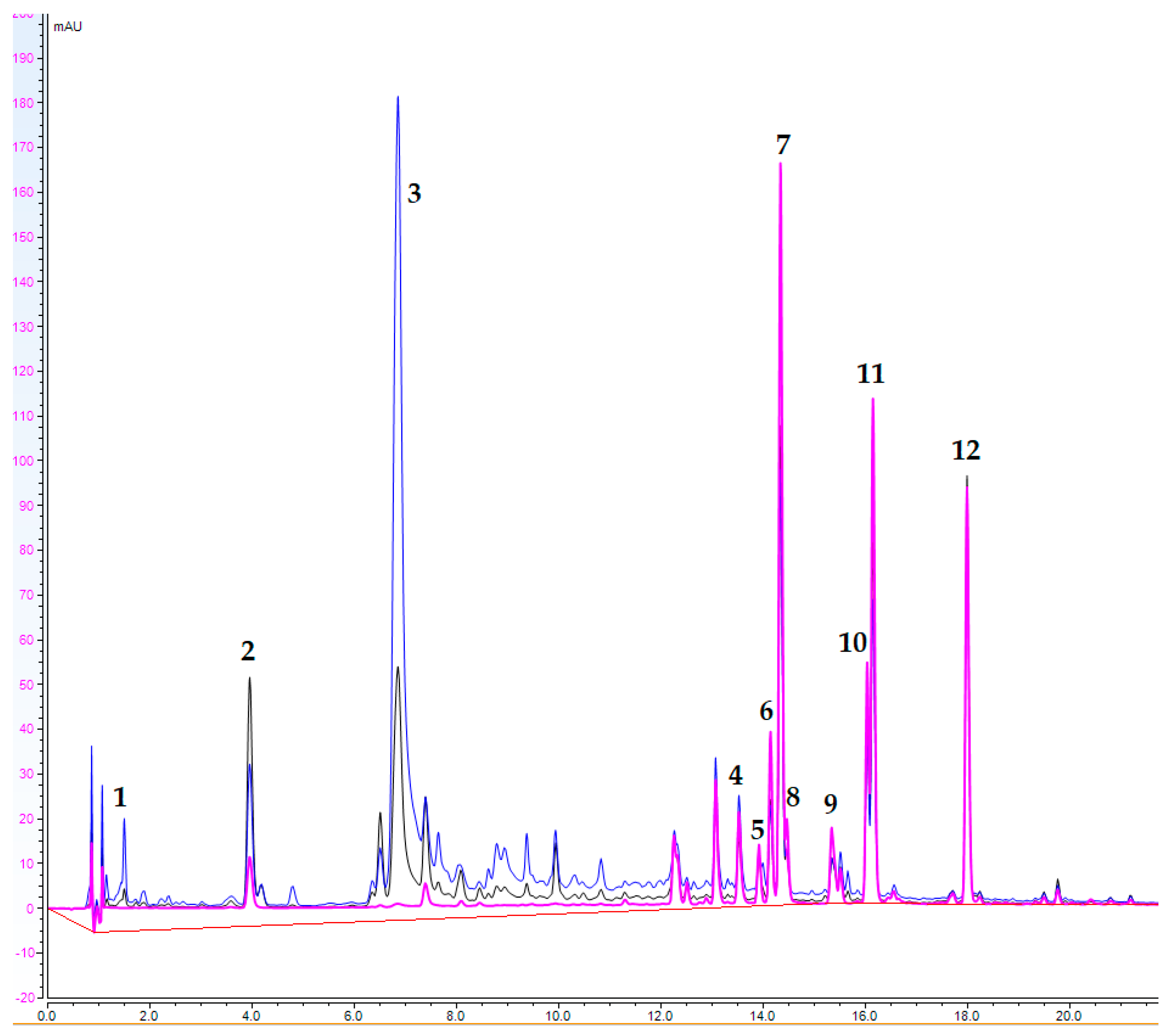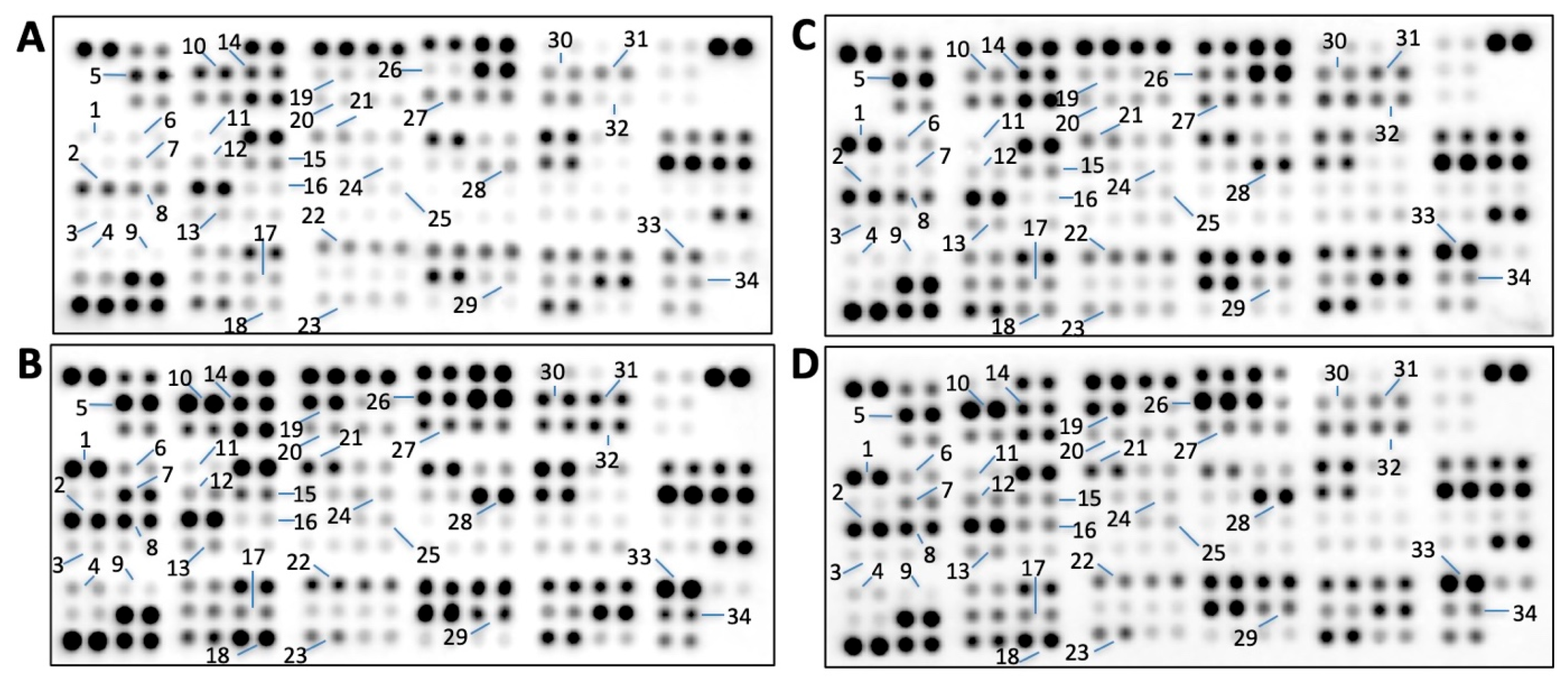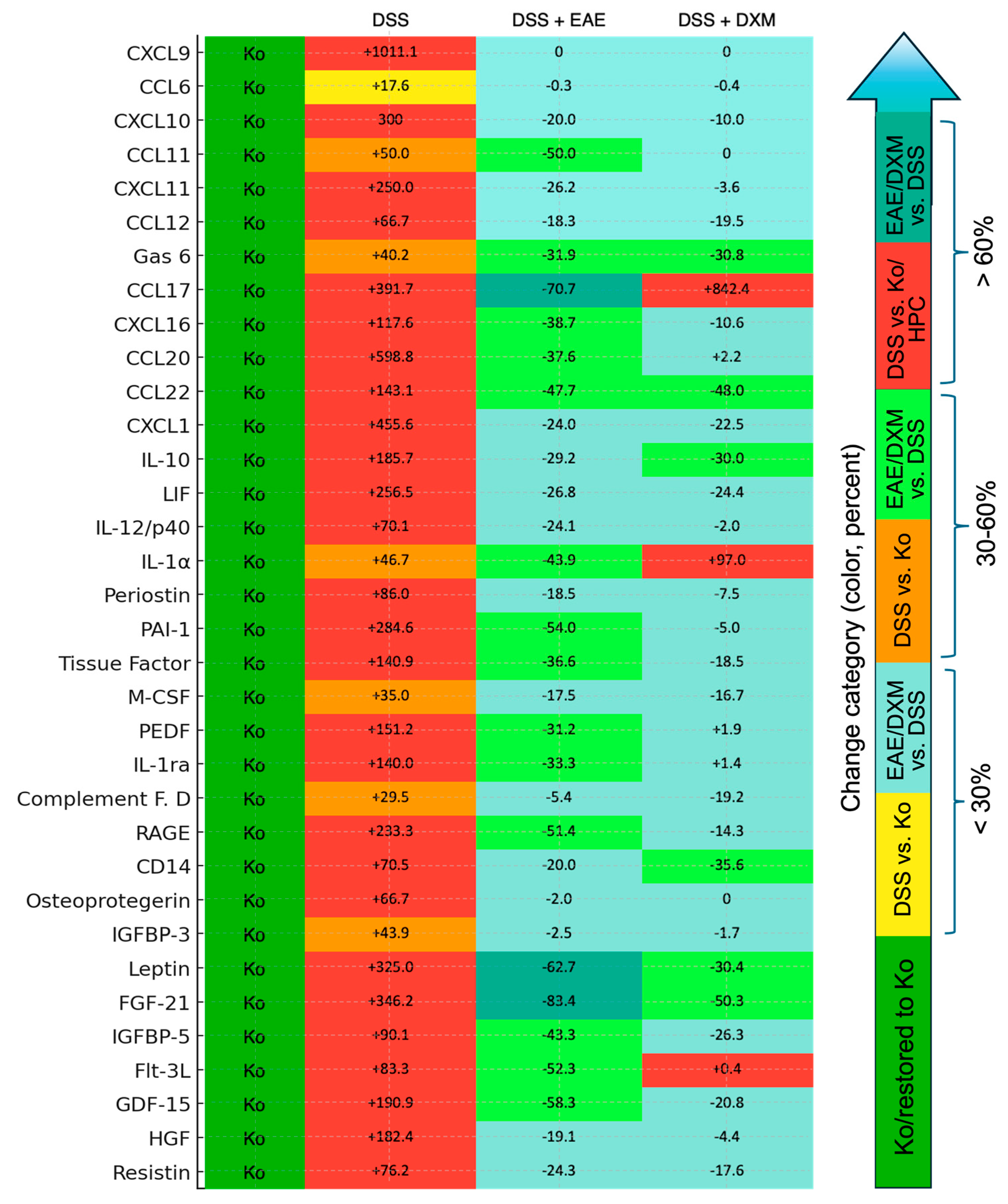Immunomodulatory Effects of Epilobium angustifolium Extract in DSS-Induced Colitis: Attenuation of Inflammatory and Metabolic Markers in Mice
Abstract
1. Introduction
2. Materials and Methods
2.1. Plant Material and Plant Extraction
2.2. Chemicals
2.3. UHPLC-DAD Analysis
2.4. Animals and Housing Conditions
Experimental Design
2.5. In Vitro Proteome Profiling Analysis
3. Results
3.1. UHPLC-DAD Analysis
3.2. Results from the In Vitro Proteome Profiling
3.2.1. Modulation of Serum Chemokine Levels
3.2.2. Modulation of Inflammation-Related Cytokines and Regulatory Factors
3.2.3. Modulation of Inflammation-Related Growth Factors and Hormones
4. Discussion
5. Conclusions
Author Contributions
Funding
Institutional Review Board Statement
Informed Consent Statement
Data Availability Statement
Conflicts of Interest
References
- Singh, V.; Johnson, K.; Yin, J.; Lee, S.; Lin, R.; Yu, H.; In, J.; Foulke-Abel, J.; Zachos, N.C.; Donowitz, M.; et al. Chronic Inflammation in Ulcerative Colitis Causes Long-Term Changes in Goblet Cell Function. Cell. Mol. Gastroenterol. Hepatol. 2022, 13, 219–232. [Google Scholar] [CrossRef] [PubMed]
- Ungaro, R.; Mehandru, S.; Allen, P.B.; Peyrin-Biroulet, L.; Colombel, J.-F. Ulcerative colitis. Lancet 2017, 389, 1756–1770. [Google Scholar] [CrossRef]
- Kobayashi, T.; Siegmund, B.; Le Berre, C.; Wei, S.C.; Ferrante, M.; Shen, B.; Bernstein, C.N.; Danese, S.; Peyrin-Biroulet, L.; Hibi, T. Ulcerative colitis. Nat. Rev. Dis. Primer. 2020, 6, 74. [Google Scholar] [CrossRef]
- Kaur, A.; Goggolidou, P. Ulcerative colitis: Understanding its cellular pathology could provide insights into novel therapies. J. Inflamm. 2020, 17, 15. [Google Scholar] [CrossRef]
- Ordás, I.; Eckmann, L.; Talamini, M.; Baumgart, D.C.; Sandborn, W.J. Ulcerative colitis. Lancet 2012, 380, 1606–1619. [Google Scholar] [CrossRef] [PubMed]
- Bamias, G.; Cominelli, F. Role of type 2 immunity in intestinal inflammation. Curr. Opin. Gastroenterol. 2015, 31, 471–476. [Google Scholar] [CrossRef]
- Heller, F.; Florian, P.; Bojarski, C.; Richter, J.; Christ, M.; Hillenbrand, B.; Mankertz, J.; Gitter, A.H.; Bürgel, N.; Fromm, M.; et al. Interleukin-13 Is the Key Effector Th2 Cytokine in Ulcerative Colitis That Affects Epithelial Tight Junctions, Apoptosis, Cell Restitution. Gastroenterology 2005, 129, 550–564. [Google Scholar] [CrossRef]
- Wedemeyer, J.; Vosskuhl, K. Role of gastrointestinal eosinophils in inflammatory bowel disease and intestinal tumours. Best Pract. Res. Clin. Gastroenterol. 2008, 22, 537–549. [Google Scholar] [CrossRef]
- Mookhoek, A.; Haasnoot, M.L.; Bredenoord, A.J.; Ma, C.; Jairath, V.; Pai, R.K. The Clinical Significance of Eosinophils in Ulcerative Colitis: A Systematic Review. J. Crohns. Colitis 2022, 16, 1321–1334. [Google Scholar] [CrossRef] [PubMed]
- Al-Haddad, S. The role of eosinophils in inflammatory bowel disease. Gut 2005, 54, 1674–1675. [Google Scholar] [CrossRef]
- Barrie, A.; Mourabet, M.E.; Weyant, K.; Clarke, K.; Gajendran, M.; Rivers, C.; Park, S.Y.; Hartman, D.; Saul, M.; Regueiro, M.; et al. Recurrent Blood Eosinophilia in Ulcerative Colitis Is Associated with Severe Disease and Primary Sclerosing Cholangitis. Dig. Dis. Sci. 2013, 58, 222–228. [Google Scholar] [CrossRef]
- Jacobs, I.; Deleu, S.; Ke, B.J.; Cremer, J.; Dilissen, E.; De Hertogh, G.; Martens, T.; Vanden Berghe, P.; Matteoli, G.; Vermeire, S.; et al. Eosinophils mitigate intestinal fibrosis while promoting inflammation in a chronic DSS colitis model and co-culture model with fibroblasts. Sci. Rep. 2024, 14, 27133. [Google Scholar] [CrossRef]
- Whetstone, C.E.; Amer, R.; Maqbool, S.; Javed, T.; Gauvreau, G.M. Pathobiology and Regulation of Eosinophils, Mast Cells, Basophils in Allergic Asthma. Immunol. Rev. 2025, 331, e70018. [Google Scholar] [CrossRef] [PubMed]
- Strober, W.; Fuss, I.J. Proinflammatory Cytokines in the Pathogenesis of Inflammatory Bowel Diseases. Gastroenterology 2011, 140, 1756–1767. [Google Scholar] [CrossRef]
- Souza, R.F.; Caetano, M.A.F.; Magalhães, H.I.R.; Castelucci, P. Study of tumor necrosis factor receptor in the inflammatory bowel disease. World J. Gastroenterol. 2023, 29, 2733–2746. [Google Scholar] [CrossRef] [PubMed]
- Iyer, S.S.; Cheng, G. Role of Interleukin 10 Transcriptional Regulation in Inflammation and Autoimmune Disease. Crit. Rev. Immunol. 2012, 32, 23–63. [Google Scholar] [CrossRef]
- Imam, T.; Park, S.; Kaplan, M.H.; Olson, M.R. Effector T Helper Cell Subsets in Inflammatory Bowel Diseases. Front. Immunol. 2018, 9, 1212. [Google Scholar] [CrossRef] [PubMed]
- Rieder, F.; de Bruyn, J.R.; Pham, B.T.; Katsanos, K.; Annese, V.; Higgins, P.D.; Magro, F.; Dotan, I. Markers of intestinal fibrosis in inflammatory bowel disease. J. Crohns. Colitis 2014, 8, 1166–1178. [Google Scholar] [CrossRef]
- Saez, A.; Herrero-Fernandez, B.; Gomez-Bris, R.; Sánchez-Martinez, H.; Gonzalez-Granado, J.M. Pathophysiology of Inflammatory Bowel Disease: Innate Immune System. Int. J. Mol. Sci. 2023, 24, 1526. [Google Scholar] [CrossRef]
- Beck, P.L.; Podolsky, D.K. Growth Factors in Inflammatory Bowel Disease. Inflamm. Bowel Dis. 1999, 5, 44–60. [Google Scholar] [CrossRef]
- Xavier, R.J.; Podolsky, D.K. Unravelling the pathogenesis of inflammatory bowel disease. Nature 2007, 448, 427–434. [Google Scholar] [CrossRef]
- Torres, M.; Ríos, A. Current view of the immunopathogenesis in inflammatory bowel disease and its implications for therapy. World J. Gastroenterol. 2008, 14, 1972. [Google Scholar] [CrossRef]
- Hyun, C.-K. Molecular and Pathophysiological Links between Metabolic Disorders and Inflammatory Bowel Diseases. Int. J. Mol. Sci. 2021, 22, 9139. [Google Scholar] [CrossRef]
- Burger, D.; Travis, S. Conventional Medical Management of Inflammatory Bowel Disease. Gastroenterology 2011, 140, 1827–1837. [Google Scholar] [CrossRef] [PubMed]
- Dreger, M.; Adamczak, A.; Seidler-Łożykowska, K.; Wielgus, K. Pharmacological properties of fireweed (Epilobium angustifolium L.) and bioavailability of ellagitannins. A review. Herba Pol. 2020, 66, 52–64. [Google Scholar] [CrossRef]
- Gevrenova, R.; Zengin, G.; Ozturk, G.; Zheleva-Dimitrova, D. Exploring the Phytochemical Profile and Biological Insights of Epilobium angustifolium L. Herb. Plants 2025, 14, 415. [Google Scholar] [CrossRef]
- Kavaz Yüksel, A.; Dikici, E.; Yüksel, M.; Işık, M.; Tozoğlu, F.; Köksal, E. Phytochemical, phenolic profile, antioxidant, anticholinergic and antibacterial properties of Epilobium angustifolium (Onagraceae). J. Food Meas. Charact. 2021, 15, 4858–4867. [Google Scholar] [CrossRef]
- Yahfoufi, N.; Alsadi, N.; Jambi, M.; Matar, C. The Immunomodulatory and Anti-Inflammatory Role of Polyphenols. Nutrients 2018, 10, 1618. [Google Scholar] [CrossRef]
- Granica, S.; Piwowarski, J.P.; Kiss, A.K. Ellagitannins modulate the inflammatory response of human neutrophils ex vivo. Phytomedicine 2015, 22, 1215–1222. [Google Scholar] [CrossRef] [PubMed]
- Banc, R.; Rusu, M.E.; Filip, L.; Popa, D.-S. The Impact of Ellagitannins and Their Metabolites through Gut Microbiome on the Gut Health and Brain Wellness within the Gut–Brain Axis. Foods 2023, 12, 270. [Google Scholar] [CrossRef] [PubMed]
- Beserra, A.M.; Calegari, P.I.; Souza Mdo, C.; Dos Santos, R.A.; Lima, J.C.; Silva, R.M.; Balogun, S.O.; Martins, D.T. Gastroprotective and Ulcer-Healing Mechanisms of Ellagic Acid in Experimental Rats. J. Agric. Food Chem. 2011, 59, 6957–6965. [Google Scholar] [CrossRef] [PubMed]
- Yoshida, T.; Yoshimura, M.; Amakura, Y. Chemical and Biological Significance of Oenothein B and Related Ellagitannin Oligomers with Macrocyclic Structure. Molecules 2018, 23, 552. [Google Scholar] [CrossRef]
- Simeonova, R.; Mihaylova, R.; Gevrenova, R.; Savov, Y.; Zheleva-Dimitrova, D. Ulceroprotective Effects of Epilobium angustifolium Extract in DSS-Induced Colitis in Mice. Curr. Issues Mol. Biol. 2015, 47, 444. [Google Scholar] [CrossRef] [PubMed]
- Kuzmanov, B. Epilobium angustifolium, L. In Flora Republicae Bulgaricae, Onagraceae; Bulgarian Academy of Sciences: Sofia, Bulgarian, 1979; Volume VII, pp. 449–454. [Google Scholar]
- Mihaylova, R.; Gevrenova, R.; Petrova, A.; Savov, Y.; Zheleva-Dimitrova, D.; Balabanova, V.; Momekov, G.; Simeonova, R. Mitigating Effects of Tanacetum balsamita L. on Metabolic Dysfunction-Associated Fatty Liver Disease (MAFLD). Plants 2024, 13, 2086. [Google Scholar] [CrossRef] [PubMed]
- Mihaylova, R.; Zheleva-Dimitrova, D.; Elincheva, V.; Gevrenova, R.; Momekov, G.; Simeonova, R. Prenanthes purpurea and 3,5-DiCQA Alleviate Cellular Stress in H2O2-Induced Neurotoxicity: An In Vitro Comparative Study. Int. J. Mol. Sci. 2024, 25, 9805. [Google Scholar] [CrossRef]
- Shin, J.M.; Son, Y.J.; Ha, I.J.; Erdenebileg, S.; Jung, D.S.; Song, D.G.; Kim, Y.S.; Kim, S.M.; Nho, C.W. Artemisia argyi extract alleviates inflammation in a DSS-induced colitis mouse model and enhances immunomodulatory effects in lymphoid tissues. BMC Complement. Med. Ther. 2022, 22, 64. [Google Scholar] [CrossRef]
- Schepetkin, I.A.; Kirpotina, L.N.; Jakiw, L.; Khlebnikov, A.I.; Blaskovich, C.L.; Jutila, M.A.; Quinn, M.T. Immunomodulatory Activity of Oenothein B Isolated from Epilobium angustifolium. J. Immunol. 2009, 183, 6754–6766. [Google Scholar] [CrossRef]
- Schepetkin, I.A.; Ramstead, A.G.; Kirpotina, L.N.; Voyich, J.M.; Jutila, M.A.; Quinn, M.T. Therapeutic Potential of Polyphenols from Epilobium angustifolium (Fireweed). Phytother. Res. 2016, 30, 1287–1297. [Google Scholar] [CrossRef]
- Schmid, D.; Gruber, M.; Piskaty, C.; Woehs, F.; Renner, A.; Nagy, Z.; Kaltenboeck, A.; Wasserscheid, T.; Bazylko, A.; Kiss, A.K.; et al. Inhibition of NF-κB-Dependent Cytokine and Inducible Nitric Oxide Synthesis by the Macrocyclic Ellagitannin Oenothein B in TLR-Stimulated RAW 264.7 Macrophages. J. Nat. Prod. 2012, 75, 870–875. [Google Scholar] [CrossRef]
- Jiang, Z.; Yan, M.; Qin, Y.; Liu, Z.; Duan, Y.; Wang, Y.; Zhang, R.; Lin, W.; Li, Y.; Xie, T.; et al. Quercetin alleviates ulcerative colitis through inhibiting CXCL8-CXCR1/2 axis: A network and transcriptome analysis. Front. Pharmacol. 2024, 15, 1485255. [Google Scholar] [CrossRef]
- Piazza, S.; Fumagalli, M.; Martinelli, G.; Pozzoli, C.; Maranta, N.; Angarano, M.; Sangiovanni, E.; Dell’Agli, M. Hydrolyzable Tannins in the Management of Th1, Th2 and Th17 Inflammatory-Related Diseases. Molecules 2022, 27, 7593. [Google Scholar] [CrossRef]
- Xu, L.; Li, W.; Chen, S.Y.; Deng, X.W.; Deng, W.F.; Liu, G.; Chen, Y.J.; Cao, Y. Oenothein B ameliorates hepatic injury in alcoholic liver disease mice by improving oxidative stress and inflammation and modulating the gut microbiota. Front. Nutr. 2022, 9, 1053718. [Google Scholar] [CrossRef]
- Marín, M.; María Giner, R.; Ríos, J.-L.; Carmen Recio, M. Intestinal anti-inflammatory activity of ellagic acid in the acute and chronic dextrane sulfate sodium models of mice colitis. J. Ethnopharmacol. 2013, 150, 925–934. [Google Scholar] [CrossRef] [PubMed]
- Kim, D.H.; Kim, J.S.; Kwon, J.H.; Kwun, I.S.; Baek, M.C.; Kwon, G.S.; Rungratanawanich, W.; Song, B.J.; Kim, D.K.; Kwon, H.J.; et al. Ellagic Acid Prevented Dextran-Sodium-Sulfate-Induced Colitis, Liver, Brain Injury through Gut Microbiome Changes. Antioxidants. 2023, 12, 1886. [Google Scholar] [CrossRef] [PubMed]
- Li, X.; Xu, L.; Peng, X.; Zhang, H.; Kang, M.; Jiang, Y.; Shi, H.; Chen, H.; Zhao, C.; Yu, Y.; et al. The alleviating effect of ellagic acid on DSS-induced colitis via regulating gut microbiomes and gene expression of colonic epithelial cells. Food Funct. 2023, 14, 7550–7561. [Google Scholar] [CrossRef]
- Ysrafil, Y.; Sapiun, Z.; Slamet, N.S.; Mohamad, F.; Hartati, H.; Damiti, S.A.; Alexandra, F.D.; Rahman, S.; Masyeni, S.; Harapan, H.; et al. Anti-inflammatory activities of flavonoid derivates. ADMET DMPK 2023, 11, 331–359. [Google Scholar] [CrossRef]
- Peng, J.; Li, H.; Olaolu, O.A.; Ibrahim, S.; Ibrahim, S.; Wang, S. Natural Products: A Dependable Source of Therapeutic Alternatives for Inflammatory Bowel Disease through Regulation of Tight Junctions. Molecules 2023, 28, 6293. [Google Scholar] [CrossRef]
- Qu, Y.; Li, X.; Xu, F.; Zhao, S.; Wu, X.; Wang, Y.; Xie, J. Kaempferol Alleviates Murine Experimental Colitis by Restoring Gut Microbiota and Inhibiting the LPS-TLR4-NF-κB Axis. Front. Immunol. 2021, 12, 679897. [Google Scholar] [CrossRef]
- Indra, M.R.; Karyono, S.; Ratnawati, R.; Malik, S.G. Quercetin suppresses inflammation by reducing ERK1/2 phosphorylation and NF kappa B activation in Leptin-induced Human Umbilical Vein Endothelial Cells (HUVECs). BMC Res. Notes 2013, 6, 275. [Google Scholar] [CrossRef] [PubMed]
- Zhu, L.; Gu, P.; Shen, H. Gallic acid improved inflammation via NF-κB pathway in TNBS-induced ulcerative colitis. Int. Immunopharmacol. 2019, 67, 129–137. [Google Scholar] [CrossRef]
- Shree, A.; Islam, J.; Vafa, A.; Mohammad Afzal, S.; Sultana, S. Gallic acid prevents 1, 2-Dimethylhydrazine induced colon inflammation, toxicity, mucin depletion, goblet cell disintegration. Environ. Toxicol. 2020, 35, 652–664. [Google Scholar] [CrossRef] [PubMed]
- Liu, W.; Li, J.; Zhang, X.; Zu, Y.; Yang, Y.; Liu, W.; Xu, Z.; Gao, H.; Sun, X.; Jiang, X.; et al. Current Advances in Naturally Occurring Caffeoylquinic Acids: Structure, Bioactivity, Synthesis. J. Agric. Food Chem. 2020, 68, 10489–10516. [Google Scholar] [CrossRef] [PubMed]
- Olave, N.C.; Grenett, M.H.; Cadeiras, M.; Grenett, H.E.; Higgins, P.J. Upstream stimulatory factor-2 mediates quercetin-induced suppression of PAI-1 gene expression in human endothelial cells. J. Cell. Biochem. 2010, 111, 720–726. [Google Scholar] [CrossRef]
- Lan, C.-Y.; Chen, S.-Y.; Kuo, C.-W.; Lu, C.-C.; Yen, G.-C. Quercetin facilitates cell death and chemosensitivity through RAGE/PI3K/AKT/mTOR axis in human pancreatic cancer cells. J. Food Drug Anal. 2019, 27, 887–896. [Google Scholar] [CrossRef] [PubMed]
- Esposito, C.; Santarcangelo, C.; Masselli, R.; Buonomo, G.; Nicotra, G.; Insolia, V.; D’Avino, M.; Caruso, G.; Buonomo, A.R.; Sacchi, R.; et al. Epilobium angustifolium L. extract with high content in oenothein B on benign prostatic hyperplasia: A monocentric, randomized, double-blind, placebo-controlled clinical trial. Biomed. Pharmacother. 2021, 138, 111414. [Google Scholar] [CrossRef]
- Paulis, G. Inflammatory mechanisms and oxidative stress in prostatitis: The possible role of antioxidant therapy. Res. Rep. Urol. 2018, 10, 75–87. [Google Scholar] [CrossRef]
- Liu, K.; Mei, F.; Wang, Y.; Xiao, N.; Yang, L.; Wang, Y.; Li, J.; Huang, F.; Kou, J.; Liu, B.; et al. Quercetin oppositely regulates insulin-mediated glucose disposal in skeletal muscle under normal and inflammatory conditions: The dual roles of AMPK activation. Mol. Nutr. Food Res. 2016, 60, 551–565. [Google Scholar] [CrossRef]
- Biyabani, A.; Ghorbani, F.; Koushki, M.; Nedaei, K.; Hemmati, M.; Mahdei, N.; Mahalleh, N.; Ghadimi, D. Quercetin and calorie restriction improve leptin/adiponectin balance through reducing high-fat diet-induced oxidative stress in male BALB/c mice. Biochem. Biophys. Res. Commun. 2025, 742, 151073. [Google Scholar] [CrossRef]
- Zhang, M.-H.; Liang, Z.-Q.; Qin, Q.; Li, S.-L.; Zhou, D.-S.; Tang, L. [Effects of quercetin on serum levels of resistin and IL-18 and on insulin resistance in nonalcoholic fatty liver disease rats]. Zhonghua Gan Zang Bing Za Zhi Zhonghua Ganzangbing Zazhi Chin. J. Hepatol. 2013, 21, 66–70. [Google Scholar] [CrossRef]
- Yamada, N.; Matsushima-Nishiwaki, R.; Kozawa, O. Quercetin suppresses the migration of hepatocellular carcinoma cells stimulated by hepatocyte growth factor or transforming growth factor-α: Attenuation of AKT signaling pathway. Arch. Biochem. Biophys. 2020, 682, 108296. [Google Scholar] [CrossRef]
- Zhai, H.; Wang, D.; Wang, Y.; Gu, H.; Jv, J.; Yuan, L.; Wang, C.; Chen, L. Kaempferol alleviates adipose tissue inflammation and insulin resistance in db/db mice by inhibiting the STING/NLRP3 signaling pathway. Endocr. Connect. 2024, 13, e230379. [Google Scholar] [CrossRef]
- Moore, W.T.; Luo, J.; Liu, D. Kaempferol improves glucose uptake in skeletal muscle via an AMPK-dependent mechanism. Food Sci. Hum. Wellness 2023, 12, 2087–2094. [Google Scholar] [CrossRef]
- Ferreira, J. Kaempferol-3-rhamnoside can help treat diabetes in mice. Lab Anim. 2024, 53, 223. [Google Scholar] [CrossRef] [PubMed]
- Wang, L.; Wei, Y.; Ning, C.; Zhang, M.; Fan, P.; Lei, D.; Du, J.; Gale, M.; Ma, Y.; Yang, Y. Ellagic acid promotes browning of white adipose tissues in high-fat diet-induced obesity in rats through suppressing white adipocyte maintaining genes. Endocr. J. 2019, 66, 923–936. [Google Scholar] [CrossRef] [PubMed]
- Zhang, X.Y.; Liu, Q.X.; Chen, Y.; Li, W.; Feng, K.H.; Xiao, J.; Cao, Y.; Su, Z.X.; Wang, G.; Chen, Y.J. Regulatory Effect and Mechanism of Oenothein B in Reducing Fat Accumulation in Caenorhabditis Elegans. Eur. J. Lipid Sci. Technol. 2023, 125, 2200077. [Google Scholar] [CrossRef]



| No | Analyte | tR | Content (mg/g de) |
|---|---|---|---|
| 1 | gallic acid | 1.5 | 0.65 ± 0.05 |
| 2 | neochlorogenic acid | 3.97 | 2.38 ± 0.47 |
| 3 | oenothein B | 6.86 | 63.60 ± 5.47 |
| 4 | ellagic acid | 13.52 | 2.23 ± 0.10 |
| 5 | myricitrin | 13.92 | 0.69 ± 0.003 |
| 6 | hyperoside | 14.14 | 2.20 ± 0.14 |
| 7 | miquelianin | 14.34 | 10.77 ± 0.87 |
| 8 | isoquercitrin | 14.48 | 0.24 ± 0.04 |
| 9 | isorhamnetin 3-O-glucoside | 15.35 | 0.90 ± 0.09 |
| 10 | kaempferol 3-O-glucoside | 16.04 | 2.99 ± 0.21 |
| 11 | quercitrin | 16.14 | 7.27 ± 0.80 |
| 12 | Fl 1 (kaempferol 3-O-deoxyhexoside) | 17.98 | 5.83 ± 0.53 |
Disclaimer/Publisher’s Note: The statements, opinions and data contained in all publications are solely those of the individual author(s) and contributor(s) and not of MDPI and/or the editor(s). MDPI and/or the editor(s) disclaim responsibility for any injury to people or property resulting from any ideas, methods, instructions or products referred to in the content. |
© 2025 by the authors. Licensee MDPI, Basel, Switzerland. This article is an open access article distributed under the terms and conditions of the Creative Commons Attribution (CC BY) license (https://creativecommons.org/licenses/by/4.0/).
Share and Cite
Mihaylova, R.; Elincheva, V.; Gevrenova, R.; Zheleva-Dimitrova, D.; Momekov, G.; Simeonova, R. Immunomodulatory Effects of Epilobium angustifolium Extract in DSS-Induced Colitis: Attenuation of Inflammatory and Metabolic Markers in Mice. Immuno 2025, 5, 50. https://doi.org/10.3390/immuno5040050
Mihaylova R, Elincheva V, Gevrenova R, Zheleva-Dimitrova D, Momekov G, Simeonova R. Immunomodulatory Effects of Epilobium angustifolium Extract in DSS-Induced Colitis: Attenuation of Inflammatory and Metabolic Markers in Mice. Immuno. 2025; 5(4):50. https://doi.org/10.3390/immuno5040050
Chicago/Turabian StyleMihaylova, Rositsa, Viktoria Elincheva, Reneta Gevrenova, Dimitrina Zheleva-Dimitrova, Georgi Momekov, and Rumyana Simeonova. 2025. "Immunomodulatory Effects of Epilobium angustifolium Extract in DSS-Induced Colitis: Attenuation of Inflammatory and Metabolic Markers in Mice" Immuno 5, no. 4: 50. https://doi.org/10.3390/immuno5040050
APA StyleMihaylova, R., Elincheva, V., Gevrenova, R., Zheleva-Dimitrova, D., Momekov, G., & Simeonova, R. (2025). Immunomodulatory Effects of Epilobium angustifolium Extract in DSS-Induced Colitis: Attenuation of Inflammatory and Metabolic Markers in Mice. Immuno, 5(4), 50. https://doi.org/10.3390/immuno5040050










